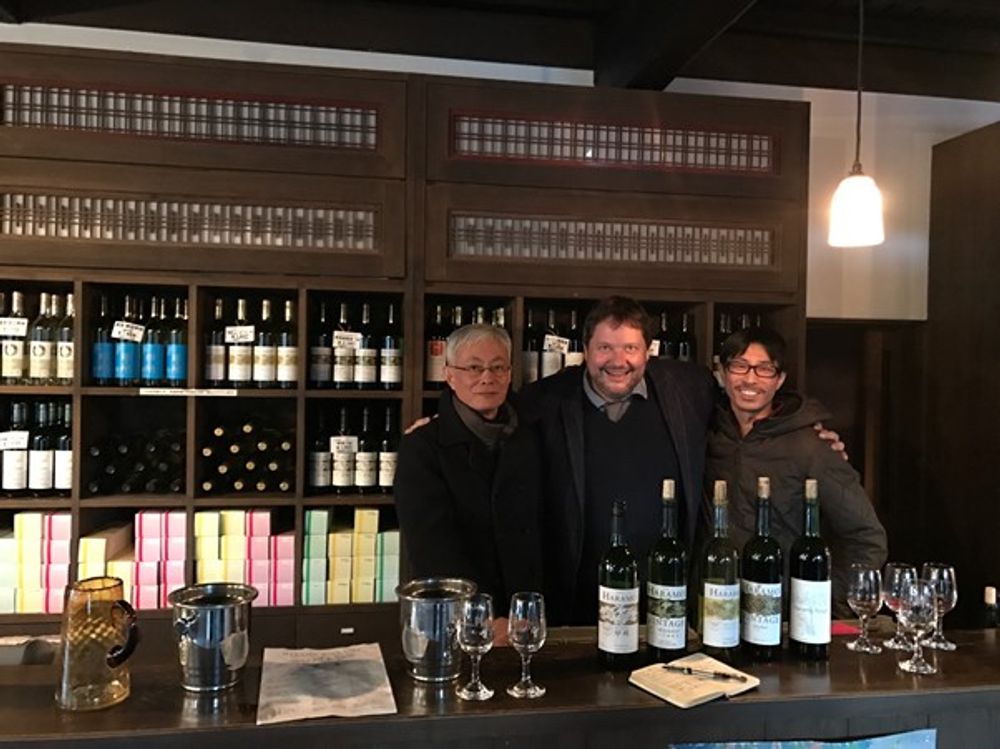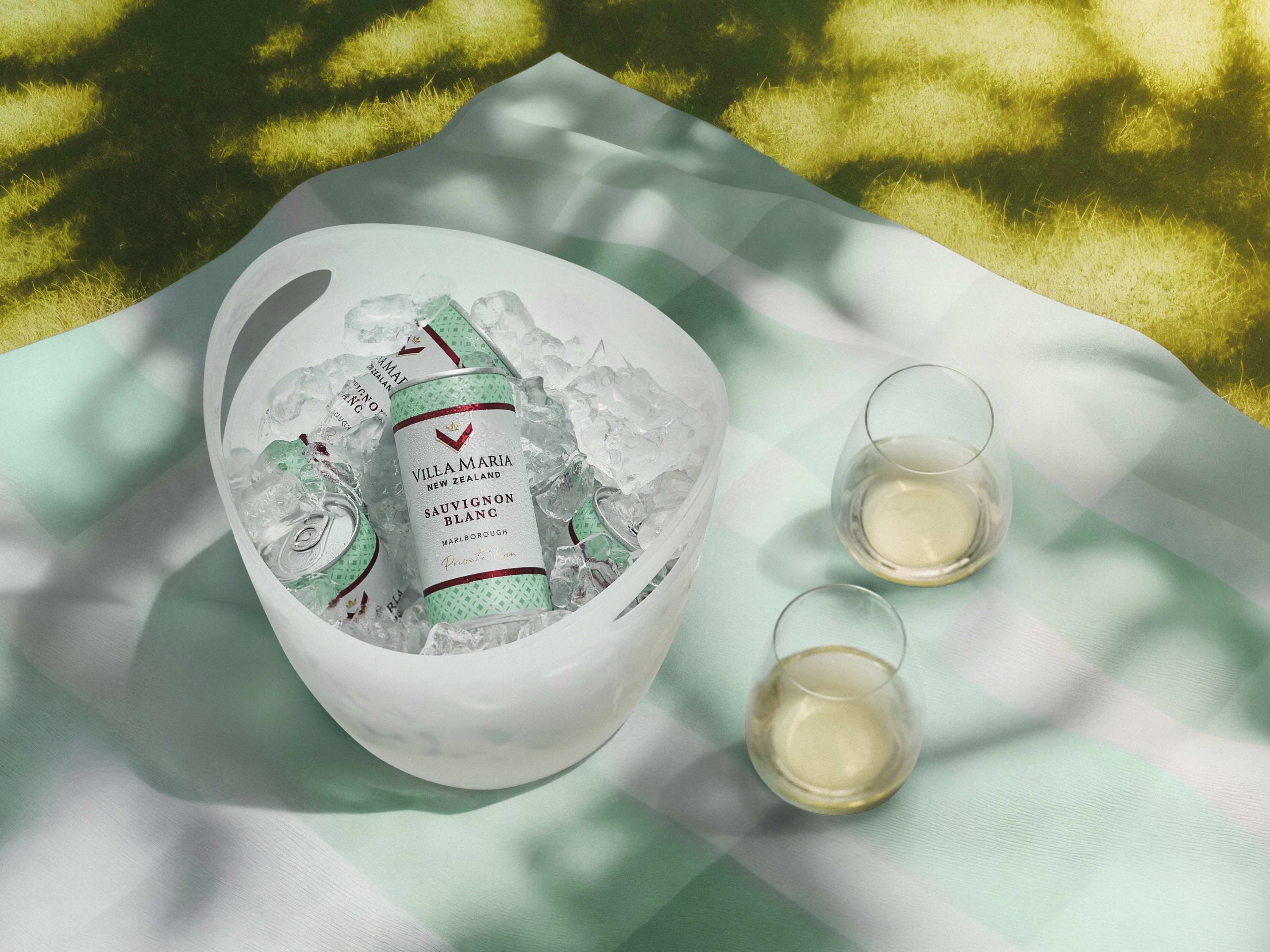“The calmer you are,” said Wadsack “the more you appreciate these wines. They are very subtle, very delicate.”
It is a sign of the times that this year’s annual Koshu tasting, run by KOJ (Koshu of Japan) was virtual, hosted on Zoom by wine author and broadcaster Jane Parkinson alongside former supermarket buyer and TV personality Joe Wadsack. “I know what you’re all thinking” joked Parkinson at the start “how on earth am I going to get a word in edgeways when I’m co-presenting with Joe?” but the duo took us expertly through the history of wine in Japan and the eight wines selected for tasting. “I was blown away by the attention to detail, the focus, the determination, the progress they’re making here,” said Parkinson and Wadsack agreed, remarking on the “beautiful, unique and individual” wines.

Jane Parkinson visiting Yamanashi
Koshu may not be a name seen on most UK wine lists but the winemaking here is prolific with Japan boasting 891 wine grape growers, equating to those of California and Chile combined. Yamanashi is the hotbed, where 80 wineries produce 40% of the national production and 95% of Japan’s Koshu.
The first evidence of grape growing dates back to 718AD but it was not until the 1500s when the Jesuits came to Japan and set up trading routes that wine was introduced to the culture, in particular red wines from Portugal’s Douro which gained rapid popularity. By the end of the 1800s people from Japan were travelling to Europe to learn about winemaking and bringing their knowledge back with them. Thus began the creation of Koshu.
The southern tip of Yamanashi sits on the base of Mount Fuji which gets a lot of rain but Katsunuma, “the beating heart” of the winemaking region, is a bordered basin which is naturally protected from typhoon clouds and deluges and acts as a sun trap. This is one of the warmest places in Japan but also has extremes of hot and cold useful for developing the grape’s flavours.

Joe Wadsack visiting Yamanashi
According to Parkinson, the combination of heat and summer rain is most comparable to Hunter Valley in Australia. The erratic nature of the seasons, with the damp and rot this brings, makes it “extremely complicated” said Wadsack to predict the nature of the vintages but, although 2020 was tricky, it was “certainly better than 2019 and 2021 looks to be quite good”.
Most Koshu is for domestic consumption with wineries exporting a maximum of 30% and the top export markets are China, Hong Kong, Singapore, the UK, and Russia. KOJ say that although the UK is not the largest market, it is the most influential and so, the most important.
And so to tasting the wines…

It was fitting to start the tasting with Château Mercian‘s Iwade Koshu Ortum 2020 as the winery has secured many firsts for Koshu including being the first to win gold at IWSC, the first to make a pink wine and the first wine in Japan to produce one million bottles. Announced as a “good introduction” to Koshu this was typically extremely pale, the proclivity to rot meaning skin contact is often avoided, and low in alcohol, it being unusual to find Koshu above 12.5%. “I love the tension of this wine” remarked Parkinson on its bright acidity, only slightly softened by a bready aftertaste from gentle lees ageing.
“The calmer you are,” said Wadsack “the more you appreciate these wines. They are very subtle, very delicate but as I have discovered they are fantastic food wines for the right western match,” listing off fish pie, gratin, and cheesy, fatty dishes which complement the zippy acidity. We tasted through the immediate tropical hit of Manns‘ Solaris Yamanashi Koshu 2020, the name a nod to the long sunshine hours these vines enjoyed and Haramo Koshu 2019 which, due to disastrous rot, was produced with bought-in grapes. Winemaker Haramo-san created this cuvée specifically for the London market, making a range of Koshu in his picturesque old wooden trading house, which people book months in advance to visit.
Grace Wine, founded in 1920 and arguably the most renowned, “produces benchmark styles which are appreciated internationally and really capture the potential and quality that you get here,” said Parkinson. Playing a “vital role in developing the Japanese wine industry in general” Grace won gold medals at the Decanter World Wine Awards in 2018 and 2019. Fifth generation winemaker, Ayana Misawa, also a Ralph Lauren model, travelled the world to soak up international expertise before taking over as head winemaker in 2011.
2020 was a tricky year, receiving the longest period of rainfall on record but the sun came out by mid-summer to rescue the season, however intense berry selection was required. “Not that you can tell,” said Parkinson of the Koshu Hishiyama Vineyard Private Reserve 2020, “it has a beautiful elegance and depth of flavour”. Joe likens it to a Cru Chablis with its “teasing salinity” and umami making it incredibly versatile with food. “More swagger, more poise” than some of the others, said Wadsack with Parkinson remarking on the “lovely lemon sourness punching its way across the palate”. It is clear that both of our hosts are salivating.
Soryu is one of the oldest and largest producers of Koshu, selling its first bottle in 1899 and playing a huge role in the country’s history and the cultural exchange of the 1800s. Unafraid of experimentation, Hikawa Valley Koshu Barrel Fermentation 2020 has had skin contact, been aged in new French oak for two and a half months and is a relatively high 12.9%. The oak is immediately apparent, and this slightly buttery, woody wine is “more phenolic than other wines we have” said Wadsack. Oak is clearly something that needs to be used with caution in Koshu. With the depth and structure of this wine we are advised to keep it cold and enjoy it with a croque monsieur.
Kurambon focuses on natural techniques and its N Koshu 2020 was a good vintage for them with the wine benefitting from the texture that organic winemaking and spontaneous fermentation can give. “I think he’s pushing the limits here,” said Parkinson “you really get that vanilla, clove, spice action and, to his credit, you still get that searing freshness through it”. “I think this wine is one of the best of his I’ve tasted,” concludes Joe.
Katsunuma Jyozo is one of the most consistent and interesting producers in Japan and Yoshichika Aruga’s studies in Macon are evident in the elegant style of the Aruga Branca Pipa 2018. “I think it is quite bold to take the decision that a 10.8% Koshu has enough hotspur,” said Wadsack “but I love this wine” likening it to somewhere between a Petit Chablis and Godello with its “raindrop falling on [your] head softness.” Of all the wines we taste, this shows the most expert hand with wood use.
Orange wine is gaining popularity and we finished with Lumière’s Prestige Class Orange 2020 which is apparently the best Parkinson has tasted. Producing wine since the 1880s and receiving a Royal Warrant, Lumière created this wine with skin and seed contact and carbonic maceration. Aged for six months in French oak this is a “fantastic example” with its apricot kernel, jammy, nuttiness which is “all to its credit.”
In conclusion…
Whether classically subtle or incorporating oak and skin contact, the drive to offer different interpretations of Koshu is resulting in increasing experimentation in Japan; this masterclass managed to provide an insight into this wine’s versatility, potential and also where Koshu may go in the future.










































